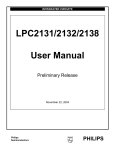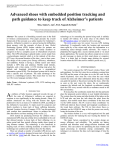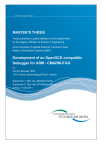Download LPC2138 Education Board
Transcript
LPC2138 Education Board - User’s Guide Copyright 2012 © Embedded Artists AB LPC2138 Education Board User’s Guide Learn everything there is to know about the new ARM7 32-bit MCU’s… Start Developing Your Applications On Day 1! EA2-USG-0904 Rev C LPC2138 Education Board - User’s Guide Page 2 Embedded Artists AB Davidshallsgatan 16 SE-211 45 Malmö Sweden [email protected] http://www.EmbeddedArtists.com Copyright 2012 © Embedded Artists AB. All rights reserved. No part of this publication may be reproduced, transmitted, transcribed, stored in a retrieval system, or translated into any language or computer language, in any form or by any means, electronic, mechanical, magnetic, optical, chemical, manual or otherwise, without the prior written permission of Embedded Artists AB. Disclaimer Embedded Artists AB makes no representation or warranties with respect to the contents hereof and specifically disclaim any implied warranties or merchantability or fitness for any particular purpose. Information in this publication is subject to change without notice and does not represent a commitment on the part of Embedded Artists AB. Feedback We appreciate any feedback you may have for improvements on this document. Please send your comments to [email protected]. Trademarks All brand and product names mentioned herein are trademarks, services marks, registered trademarks, or registered service marks of their respective owners and should be treated as such. Copyright 2012 © Embedded Artists AB LPC2138 Education Board - User’s Guide Page 3 Table of Contents 1 Document Revision History 5 2 Introduction 6 2.1 Contents 6 2.2 Features 6 2.3 Expansion Connector 7 2.4 Experiment Expansion Board 7 2.5 ESD Precaution 8 2.6 General Handling Care 8 2.7 CE Assessment 8 2.8 Other Products from Embedded Artists 9 2.8.1 Design and Production Services 9 2.8.2 OEM / Education / QuickStart Boards and Kits 9 3 Board Design 3.1 Board Schematics 10 3.1.1 Page 2: CPU – LPC2138 10 3.1.2 Page 2: USB – only if LPC214x mounted 10 3.1.3 Page 2: Expansion Connector 10 3.1.4 Page 3: OpenOCD Compatible JTAG Interface 11 3.1.5 Page 3: UART#0 and ISP 11 3.1.6 Page 3: Reset Generation and I2C E2PROM 11 3.1.7 Page 3: Power Supply 12 3.1.8 Page 4: Audio Interface 12 3.1.9 Page 5: Push-buttons and LEDs 12 3.1.10 Page 5: RGB-LED 12 3.1.11 Page 5: Analog Input 12 3.1.12 Page 5: Touch-sensor Keys 13 3.1.13 Page 5: XBee™ RF Module 13 3.2 Jumpers 14 3.3 Connectors 15 3.4 Important Components 16 3.5 Mechanical Dimensions 17 3.6 Audio Interface 18 4 Breadboard Experiments Copyright 2012 © Embedded Artists AB 10 19 4.1 Experiment 1: 7-segment LED Display 20 4.2 Experiment 2: 7-segment Decoder 22 4.3 Experiment 3: Counter 23 4.4 Experiment 4: Shift Register 24 4.5 Experiment 5: I2C Temperature Sensor 25 4.6 More Experiments 26 LPC2138 Education Board - User’s Guide Page 4 5 Getting Started 5.1 Test program 27 5.2 Program Development 27 5.3 Program Download via external JTAG 27 5.4 Program Download via Internal JTAG 28 5.5 Program Download via ISP 30 5.6 FTDI USB Driver 32 5.6.1 USB Driver Behavior 6 Further Information Copyright 2012 © Embedded Artists AB 27 35 36 LPC2138 Education Board - User’s Guide Page 5 1 Document Revision History Revision Date Description A 2009-05-25 Original version B 2010-12-21 Removed information about DVD, which is not included in the kit (information is now instead on support page). C 2012-01-13 Added note about CE marking. Removed schematic from document. Copyright 2012 © Embedded Artists AB LPC2138 Education Board - User’s Guide Page 6 2 Introduction Thank you for buying Embedded Artists’ LPC2138 Education Board based on NXP’s ARM7TDMI LPC2138 microcontroller. This document is a User’s Guide that describes the LPC2138 Education Board hardware design. It also covers some basic software interface principles regarding the hardware. Embedded Artists has also created another document containing many experiments that will guide you through the art of embedded program development. 2.1 Contents The box received when ordering the LPC2138 Education Board contains: The LPC2138 Education Board A component box containing o 1 pcs 7-segment display o 1 pcs 74HC590 logic chip in DIL package o 1 pcs 74HC595 logic chip in DIL package o 1 pcs 74HC4511 logic chip in DIL package o 1 pcs DS1621 temperature sensor in DIL package o 8 pcs 330 ohm resistors o Package of single wire cables A 50 pos flat cable for expansion A USB cable of type: mini-B-to-A, for powering and communicating with the boards from a PC 2.2 Features Embedded Artists LPC2138 Education Board with NXP’s ARM7TDMI LPC2138 microcontroller lets you get up-and-running quickly. The small form factor board offers unique features that ease your learning curve and speed up your program development. Here are some of the features: NXP ARM7TDMI LPC2138 microcontroller with 512 KByte program Flash and 32 KByte SRAM 14.7456 MHz crystal for maximum execution speed and standard serial bit rates On-board Peripherals Copyright 2012 © Embedded Artists AB Audio interface via 3.5mm headphone and microphone connectors UART-to-USB bridge interface on UART #0 (based on FTDI FT2232 chip) OpenOCD compatible embedded JTAG interface (based on FTDI FT2232 chip) Analog input (via trimmer potentiometer) Digi/MaxStream XBee™ module interface (module not included) RGB-LED, each color can be controlled via PWM signal 5 LEDs (connected to signals P0.14 and P1.20-23) 5 Pushbuttons (connected to signals P0.14 and P1.16-19) Reset push-button and Reset- LED LPC2138 Education Board - User’s Guide 2 Kbit I2C E2PROM Connectors Mini-B USB connector to UART#0 UART-to-USB bridge and powering as well as for OpenOCD compatible JTAG interface JTAG connector that can override the embedded OpenOCD interface 32-pos expansion connector to breadboard experiment area 50 pos expansion connector On-board low-dropout voltage and reset generation. Generates +3.3V for powering the LPC2138 +3.3V available for external circuits, up to 300 mA Powered directly from the mini-B USB connector Simple and automatic program download via: OpenOCD compatible JTAG interface, or ISP (In-System Programming) via UART-to-USB bridge channel, containing circuit that automatically controls activation of the bootloader Dimensions: 127 x 120 mm 2.3 Page 7 Four layer PCB (FR-4 material) for best noise immunity Expansion Connector A 50 pos expansion connector allows the LPC2138 Education Board to be expanded with custom hardware for exciting experiments. The following signals are available on the expansion connector: 2.4 P0.0 - P0.23 P0.25 - P0.31 Reset Vref Vbat Power; VCC (+3.3V), GND and Vin (+5V) Experiment Expansion Board There is an expansion board called the Experiment Expansion Board that can be bought separately for more interesting and useful experiments. For details about the board, see the Experiment Expansion Board page on Embedded Artists website. The picture below show how the LPC2138 Education Board can be directly connected to the Experiment Expansion Board via the expansion connector and a 50 pos flat cable. Copyright 2012 © Embedded Artists AB LPC2138 Education Board - User’s Guide Page 8 Figure 1 - LPC2138 Education Board with Experiment Expansion Board 2.5 ESD Precaution Please note that the LPC2138 Education Board come without any case/box and all components are exposed for finger touches – and therefore extra attention must be paid to ESD (electrostatic discharge) precaution. Make it a habit always to first touch the metal surface of one of the USB connectors for a few seconds with both hands before touching any other parts of the boards. That way, you will have the same potential as the board and therefore minimize the risk for ESD. In general, touch as little as possible on the LPC2138 Education Board. The push-buttons on the board have grounded shields to minimize the effect of ESD. Note that Embedded Artists does not replace boards that have been damaged by ESD. 2.6 General Handling Care Handle the LPC2138 Education Board with care. The board is not mounted in a protective case/box and is not designed for rough physical handling. Connectors can ware out after excessive use. The board is designed for prototyping and experiment use, and not for integration into an end-product. For boards with LCD, do not exercise excessive pressure on the LCD glass area. That will damage the display. Also, do not apply pressure on the flex cables connecting the LCD/touch screen. These are relatively sensitive and can be damaged if too much pressure is applied to them. Note that Embedded Artists does not replace boards where the LCD has been improperly handled. 2.7 CE Assessment The LPC2138 Education Board is CE marked. See separate CE Declaration of Conformity document. The LPC2138 Education Board is a class B product. EMC emission test has been performed on the LPC2138 Education Board. The USB interface has been in use and also powered the device during the test. General expansion connectors where internal signals are made available (for example processor pins) have been left unconnected. Connecting other devices to the product via the general expansion connectors may alter EMC emission. It is the user’s responsibility to make sure EMC emission limits are not exceeded when connecting other devices to the general expansion connectors of the LPC2138 Education Board. Copyright 2012 © Embedded Artists AB LPC2138 Education Board - User’s Guide Page 9 Due to the nature of the LPC2138 Education Board – an evaluation board not for integration into an end-product – fast transient immunity tests and conducted radio-frequency immunity tests have not been executed. Externally connected cables are assumed to be less than 3 meters. The general expansion connectors where internal signals are made available do not have any other ESD protection than from the chip themselves. Observe ESD precaution. 2.8 Other Products from Embedded Artists Embedded Artists have a broad range of LPC1000/2000/3000/4000 based boards that are very low cost and developed for prototyping / development as well as for OEM applications. Modifications for OEM applications can be done easily, even for modest production volumes. Contact Embedded Artists for further information about design and production services. 2.8.1 Design and Production Services Embedded Artists provide design services for custom designs, either completely new or modification to existing boards. Specific peripherals and I/O can be added easily to different designs, for example, communication interfaces, specific analog or digital I/O, and power supplies. Embedded Artists has a broad, and long, experience in designing industrial electronics in general and with NXP’s LPC1000/2000/3000/4000 microcontroller families in specific. Our competence also includes wireless and wired communication for embedded systems. For example IEEE802.11b/g (WLAN), Bluetooth™, ZigBee™, ISM RF, Ethernet, CAN, RS485, and Fieldbuses. 2.8.2 OEM / Education / QuickStart Boards and Kits Visit Embedded Artists’ home page, www.EmbeddedArtists.com, for information about other OEM / Education / QuickStart boards / kits or contact your local distributor. Copyright 2012 © Embedded Artists AB LPC2138 Education Board - User’s Guide Page 10 3 Board Design This chapter contains detailed information about the electrical and mechanical design of the LPC2138 Education Board. The schematic can be downloaded in pdf format from the support page, and is recommended to have printed out while reading this chapter. 3.1 Board Schematics The following subsections describe in more detail each part of the design, page by page in the schematic. 3.1.1 Page 2: CPU – LPC2138 The core part of the design is the NXP LPC2138 microcontroller. It is an ARM7TDMI-S CPU core with many different peripheral units and on-chip memory (512 kByte FLASH and 32 kByte SRAM). There is no external memory bus interface. The microcontroller crystal frequency is 14.7456 MHz. This frequency has been selected in order to allow close to maximum execution speed (4 x 14.7456 MHz = 58.9824 MHz) as well as to provide standard serial communication bit rates. The maximum cpu clock frequency is 60 MHz. There is also a 32.768 kHz crystal clock for the on-chip real-time clock peripheral unit or RTC for short. The microcontroller can be placed in a very low power mode while the RTC operates and keeps track of time. Power for the RTC (during these low power modes) comes from the VBAT input pin. Power is sourced either from the +3.3V power supply or the external VBAT_IN signal (available on the expansion connector), depending on which one have the highest voltage. The LPC2138 also contains an Analog-to-Digital Converter or ADC for short, as well as a Digital-toAnalog Converter (DAC). These two peripheral units need a reference voltage, which is supplied from the VREF input pin. Jumper J3 selects two different sources for VREF, either the +3.3V power supply (low-pass filtered for noise immunity) or an external precision voltage, the VREF_IN pin on the expansion connector. 3.1.2 Page 2: USB – only if LPC214x mounted Note that different cpu’s can be mounted on the board. The primary version is LPC2138 but any processor in the LPC213x and LPC214x series will fit (mounted on special orders). If a LPC214x family member is mounted there will be an additional USB interface on the board. This optional part of the design is also found on schematic page 2. The LPC214x contains a USB 2.0 device interface as one of its peripheral units. Low-pass filtering and ESD protection has been added for noise immunity. The USB interface supports the Soft Connect functionality and voltage sense (see LPC214x User’s Manual for more information about these functions). The Soft Connect feature is controlled by IO-pin P0.31 and is activated by placing a 1.5 kohm resistor between the D+ signal and +3.3V. A green LED also light when the resistor is enabled. The voltage sense feature is handled by IO-pin P0.23, which is connected to VCC of the USB interface. 3.1.3 Page 2: Expansion Connector The LPC2138 Education Board is not a monolithic design. It includes a breadboard for smaller electrical experiments. Expansion connector J2 allows easy access to most LPC2138 pins. There is another expansion connector (J1, a standard 50 pos, 2x25, shouldered pin list with 100 mil pin spacing) that makes it possible to expand the design on your own hardware. The Experiment Expansion Board can be connected via this expansion connector. Most LPC2138 pins are available on this expansion connector as well. Copyright 2012 © Embedded Artists AB LPC2138 Education Board - User’s Guide Page 11 All cpu signals available on the expansion connectors are protected with 270 ohm series resistors. It’s not a foolproof protection but will at least reduce the risk for shorts (for example grounding an output pin) and ESD damages on the board. The +5V (Vin) and +3.3V power voltages are available on the expansion connectors. Note that the current consumption of external circuitry on the breadboard / expansion boards should not exceed 300 mA. Since power is drawn from the USB connector, the USB Host in the other end (typically a PC) will shut down the current delivery completely. 3.1.4 Page 3: OpenOCD Compatible JTAG Interface The JTAG interface of the LPC2138 shares 6 general IO-pins (GPIOs) and is enabled by inserting a jumper on J18, i.e., pulling P1.26 low during reset. When the JTAG interface is enabled, the 6 IO-pins cannot be used for other purposes than the JTAG interface. The heart of the internal JTAG interface is the FT2232 chip from FTDI. It is a dual channel USB interface/bridge chip. Besides being pure serial interfaces there is a parallel interface also. This parallel interface, on one of the dual channels, is used to create a JTAG interface to the LPC2138 cpu. The interface is compatible with the open source OpenOCD JTAG software. Note that there is also a connector (J5) for an external JTAG interface (in case the internal JTAG interface is not used). J5 is a ‘standard’ ARM JTAG interface, i.e., a 20-pin (2x10) connector with shoulders. By placing jumpers J7, J8, J9, J10, J12, J13, J15 in correct position the LPC2138 JTAG interface will be connected to the external JTAG connector instead of the interface OpenOCD compatible JTAG interface. 3.1.5 Page 3: UART#0 and ISP UART#0 on the LPC2138 is connected to the second channel of the FT2232 chip. This channel is used as a USB-to-serial bridge. The serial interface is not a full interface, only the receive and transmit signals are connected to UART#0. There are two LEDs connected to the USB-to-serial channel. These indicate Rx and Tx activity and can be a good help when determining if a connection with the board is working properly. There is a special circuit to automate the ISP feature (In-System Programming). With the help of two control signals (RTS and DTR), the processor can be placed in bootloader mode. The bootloader uses UART#0 for downloading new program images into the processor (either into FLASH or into RAM). DTR controls the processor reset and RTS can pull signal P0.14 low. The signals are pulled low via diodes. If the processor samples P0.14 low after reset the bootloader is entered, or else the application code is executed. The automatic ISP functionality can be disabled by removing two of the four jumpers on J11. Note that some terminal programs (notably Windows™ Hyperterminal) control the RTS/DTR signals in an unfavorable way making the board always enter bootloader mode or reset mode. In these cases, the jumpers must be removed. Note that UART#0 (P0.0 and P0.1) could be disconnected from the USB-to-serial bridge by removing all four jumpers on J11. 3.1.6 Page 3: Reset Generation and I2C E2PROM The reset generation is handled by a mixed-signal chip, CAT1025 from Catalyst Semiconductor. The reset signal will be held active (i.e., low) until the supply voltages, +3.3V, is within margins. The reset duration is typically 200 mS (consult the CAT1025 datasheet for exact details). There is a reset pushbutton (SW1) as well as a red LED (LED6) that lights when the reset signal is active. The CAT1025 chip also contains a 2kbit E2PROM accessible via the I2C interface. The I2C communication channel can be used to easily connect more peripheral units, just as long as the addresses do not collide. The address of the 2kbit E2PROM is 0xA0. Note the 3k pull-up resistors, found on page 2 in the schematic, are always needed on I2C busses. Copyright 2012 © Embedded Artists AB LPC2138 Education Board - User’s Guide 3.1.7 Page 12 Page 3: Power Supply The power supply uses a conventional low-dropout voltage regulator, the Sipex SP1117. The LPC2148 need only a single +3.3V voltage and has an internal 1.8V regulator for powering the core. Some other processors in the LPC2xxx series require both a +3.3V and a +1.8V voltage. For a full specification of the SP1117 voltage regulator see the datasheet from Sipex. Power is drawn from the USB connector, which void the need for an external power supply. There are three pads to ease measurements of the incoming (+5V/Vin) voltage and the generated (+3.3V) voltage, see PAD1 – PAD3. A green LED (LED5) indicates the presence of +3.3V voltage. 3.1.8 Page 4: Audio Interface The analog output of the LPC2138, available as an alternative function on pin P0.25, can also be connected to a speaker (with associated amplifier) via jumper connector J20. Volume can be adjusted via a trimming potentiometer. The amplifier is powered from +5V (VIN). There is also a microphone input, designed for audio frequencies. The amplification factor can be adjusted via a trimming potentiometer (R73). The microphone amplifier is powered from +3.3V. The audio interface (input and output) is compatible with a standard headphone that can be bought for PC:s. 3.1.9 Page 5: Push-buttons and LEDs There are five push-buttons and LEDs. Four of the push-buttons are connected to P1.20-P1.23. Four of the LEDs are controlled by P1.16-P1.19. The LEDs light when signals are pulled low. Signal P0.14 is connected both to a push-button and a LED. Signal P0.14 has got many alternative functions. Besides being a general purpose i/o-pin, it can be configured as an interrupt input pin on the processor. The signal is also used to enable ISP mode (programming processor flash via UART#0). The signal must be sampled high after reset in order to start normal program execution; or else the internal bootloader will be activated (ISP mode). 3.1.10 Page 5: RGB-LED There is a full color RGB-LED that could be controlled by pulse width modulated (PWM) signals. The intensity of each LED can easily be controlled by adjusting the duty cycle of the signals. The list below explains the signal connections. Red LED, controlled by signal P0.17 – MAT1.2 Blue LED, controlled by signal P0.18 – MAT1.3 Green LED, controlled by signal P0.21 – PWM5 The MAT signals are available as alternative signals on the pins and are generated from the timer peripheral unit. Timer 1 must be used to control the red and blue LEDs. Similarly, the PWM signals are available as alternative signals on the pins and are generated from the PWM peripheral unit. PWM unit 5 controls the green LED. Note that the LEDs are driven from the +5V power supply. The reason for that is that the forward voltage drop of the blue LED is typically around 3.5V, which is more than the 3.3V power supply for the LPC2138. 3.1.11 Page 5: Analog Input The LPC2138 has got 14 analog inputs connected to two different 10-bit ADC (Analog-to-Digital Converter). The conversion time is as short as 2.44 us and the input pins VREF and VSSA are used as conversion reference. There is one trimming potentiometer that is used to generate a variable voltage to analog input #1 (P0.28-AIN1). Copyright 2012 © Embedded Artists AB LPC2138 Education Board - User’s Guide Page 13 The signal P0.28 can be used as general purpose pin if the analog input is not used. In this case, the analog voltage from the trimming potentiometer is easily disconnected by removing the jumper on J22. 3.1.12 Page 5: Touch-sensor Keys The two touch sensor keys are created in the top copper layer in the printed circuit board (pcb). The sensors function in pairs, where the difference between the two is measured in order to detect a touch on one of them. The principle is to measure the capacitance, which is affected then a human finger is above (i.e., touches) the copper layout in the pcb. In order to measure the relative capacitance on C51, P1.24 is configured as an input and P1.25 as an output. P1.25 is pulled high and the time until P1.24 is also high is measured. The higher capacitance, the longer time it takes to detect a high level on P1.24. By comparing the time difference between C51 and C52 touches can be detected. Note that the design is simplistic and might not be fully functional over a large temperature range and/or humidity range. A more advanced design is needed for better performance. The design however serves as illustrating the principle for simple touch detection. 3.1.13 Page 5: XBee™ RF Module There is a connector for Digi/MaxStream’s XBee™ modules. Both XBee and XBee Pro modules can be used. Note that the XBee module is not included and must be purchased separately (for example from www.digikey.com). The module is connected to UART channel #1. Four control signals are used to control the interface to the module. Three LEDs indicate the status of the module. Copyright 2012 © Embedded Artists AB LPC2138 Education Board - User’s Guide 3.2 Page 14 Jumpers The LPC2138 Education Board has got a number of jumpers. Figure 2 illustrates where the jumpers can be found. The picture below also illustrates the default positions for all jumpers. Enable JTAG J18 Select JTAG J7-J10, J12, J13, J15 UART & Automatic ISP J11 Analog Input J22 I2C to U10 (CAT1025) J17 Figure 2 - LPC2138 Education Board Jumpers Copyright 2012 © Embedded Artists AB VREF Select J3 Audio Interface J20 LPC2138 Education Board - User’s Guide 3.3 Page 15 Connectors Figure 3 illustrate the position of the two external connectors on the LPC2138 Education Board. Mini-B USB J6 Mini-B USB J4 (not mounted) Audio Out J19 Audio In J21 External JTAG J5 XBee connector U15 Figure 3 - LPC2138 Education Board External Connectors Copyright 2012 © Embedded Artists AB Expansion connector J1 LPC2138 Education Board - User’s Guide 3.4 Page 16 Important Components Figure 4 illustrates the position on the board for some important components in the design. USB RX/Tx LEDs Audio out volume (R71) Audio in amplification (R73) FT2232 (U6) RGB-LED (LED15) Reset pushbutton and LED LPC2138 (U1) Trimming potentiometer (R26) EEPROM and Reset Generator (U10) LED10-LED14 SW2-SW5 Push-buttons Figure 4 - LPC2138 Education Board Important Components Copyright 2012 © Embedded Artists AB P0.14 Pushbutton (SW6) and LED (LED8) Touch-sensors (C51 and C52) LPC2138 Education Board - User’s Guide 3.5 Page 17 Mechanical Dimensions Figure 5 contains a drawing of the board that includes mechanical measures. 108 mm 120 mm 5.5 mm 60 mm 116 mm 127 mm Figure 5 - LPC2138 Education Board Mechanical Dimensions Copyright 2012 © Embedded Artists AB 5.7 mm LPC2138 Education Board - User’s Guide 3.6 Page 18 Audio Interface The LPC2138 Education Board has got an audio interface with both audio in and out. The speaker volume can be adjusted with a trimming potentiometer and the microphone amplification can also be adjusted with a trimming potentiometer. See Figure 6 for an illustration where to find the trimming potentiometers and which way to turn them for increased volume/amplification. Pink connector from microphone Audio out volume Increased volume to right Black connector to speakers The audio interface is compatible with a standard headphone that can be bought for PC:s. The connectors are standard 3.5mm plugs. The black plug is the speaker and the pink plug is the microphone. J20 Audio in amplification Increased amplification to right Figure 6 - LPC2138 Education Board Audio Interface Note that the LPC2138 Education Board has not been designed for high-quality audio. The ADC and DAC of the LPC2138 are not high performance from an audio perspective. Therefore there will be noticeable audio noise in the audio data. Copyright 2012 © Embedded Artists AB LPC2138 Education Board - User’s Guide Page 19 4 Breadboard Experiments A mayor part of the LPC2138 Education Board is occupied by a breadboard. A component box with some basic components is included in the board kit. These components shall be mounted on the breadboard for electronic experiments and programming exercises of how to control external hardware. The components included in the box are: 7-segment display for experimenting with LEDs and controlling multiple LEDs simultaneous. 330 ohm resistors for limiting the current through the 7-segment LEDs. 74HC590 logic chip for experimenting with a binary counter with a storage register and 3state output. The datasheet is found at: http://www.nxp.com/acrobat_download/datasheets/74HC590_2.pdf 74HC595 logic chip for experimenting with a serial shift register connected to the spi-bus. The datasheet is found at: http://www.nxp.com/acrobat_download/datasheets/74HC_HCT595_4.pdf 74HC4511 logic chip for experimenting with BCD to 7-segment decoders as an alternative way of driving the 7-segment display. The datasheet is found at: http://www.standardics.nxp.com/products/hc/datasheet/74hc4511.pdf DS1621 I2C temperature sensor for experimenting with sensors and communication over the I2C serial bus. The datasheet is found at: http://datasheets.maxim-ic.com/en/ds/DS1621.pdf A package of single wire cables for connecting the components on the breadboard to the expansion connectors on the LPC2138 Education Board. It is necessary to read the datasheets of the different integrated circuits in order to experiment with them. Figure 7 illustrate the expansion connector (J2) for interfacing the LPC2138 signals, the power connectors (J14 / J16) for powering the breadboard design and the breadboard itself. Text on the pcb locates where to find the different signals on the expansion and power supply connectors. Note that there is no current limiting protection on the powering. Be careful not to short Vin or +3.3V to GND. Also note that only the wires should be used to connect to expansion connector J2. The wires on the resistors are too thin and result in unreliable connections. Copyright 2012 © Embedded Artists AB LPC2138 Education Board - User’s Guide Page 20 Power connectors J14/J16, for powering breadboard electronics. See text on pcb to locate VIN (+5V), +3.3V and GND. Expansion connector for breadboard J2, see text on pcb to locate LPC2138 signals Breadboard area Figure 7 - LPC2138 Education Board Breadboard 4.1 Experiment 1: 7-segment LED Display In this experiment a 7-segment display shall be controlled. One output pin shall drive one LED segment. The port pins of the LPC2138 microcontrollers have got a 4 mA driving capacity, enough to directly drive the LEDs in a 7-segment display. There are actually 8 LEDs since there is also a dot LED. Figure 8 illustrates how to connect the 7-segment LED display on the breadboard to the expansion connector (J2). The LEDs in the display are connected to pin P0.8 - P0.15. The 380 ohm resistors (plus the internal 270 ohm resistor on the board) limit the current to about 2.75 mA. The LEDs in the display are connected with common cathode. A high output pin on the LPC2138 drives current through a LED and it will light. Note that the resistors cannot be connected directly to expansion connector J2 since the wires are too thin. It would result in unreliable connections. Figure 9 illustrates one way of how the wiring can be done. There are several other solutions of how to do it. Copyright 2012 © Embedded Artists AB LPC2138 Education Board - User’s Guide Page 21 Figure 8 – Experiment #1: 7-segment LED Display The picture below illustrates how the circuit can be created on the breadboard. Wires are drawn in the picture (instead of a picture of the wires) in order to increase visibility. Figure 9 – Experiment #1: 7-segment LED Display Wiring Copyright 2012 © Embedded Artists AB LPC2138 Education Board - User’s Guide 4.2 Page 22 Experiment 2: 7-segment Decoder In this experiment the 7-segment display is still used but the segments are not directly driven by output pins on the LPC2138. Instead a BCD to 7-segment decoder chip (74HC4511) is used. The LPC2138 output the digit to display on BCD coding on P0.8-P0.11. See the 74HC4511 datasheet for details how to control the three control inputs of the chip. Figure 10 – Experiment #2: 7-segment Decoder Figure 11 – Experiment #2: 7-segment Decoder Wiring Copyright 2012 © Embedded Artists AB LPC2138 Education Board - User’s Guide 4.3 Page 23 Experiment 3: Counter This experiment builds on the previous experiment. A binary counter with a storage register and 3state outputs (74HC590) should be controlled from the LPC2138. The four lower output bits (LSB) from the counter drives the 7-segment display via the decoder chip (74HC4511). See the 74HC590 datasheet for details of how to control the four inputs. Figure 12 – Experiment #3: Counter Copyright 2012 © Embedded Artists AB LPC2138 Education Board - User’s Guide 4.4 Page 24 Experiment 4: Shift Register This experiment is yet another way of controlling the 7-segment display. This time via a shift register. The shift register (74HC595) is connected to the SPI bus on the LPC2138. See the 74HC595 datasheet for details of how to control the five inputs. First, use the LPC2138 in GPIO-mode and simulate the spi-bus. Verify that the display can be controlled. When this works, switch to use the spi-bus to transfer a byte (i.e., 8 bits) to the shift register. It is also possible to read back the bits in the shift register. P0.5 is connected to the last bit in the shift register. P0.5 is the spi-bus input (MISO). Figure 13 – Experiment #4: Shift Register Copyright 2012 © Embedded Artists AB LPC2138 Education Board - User’s Guide 4.5 Page 25 Experiment 5: I2C Temperature Sensor In this experiment a temperature sensor shall be connected to the I2C bus. On the LPC2138 the I2C interface is available on pins P0.2 and P0.3. P0.2 is SCL and P0.3 is SDA. Study the DS1621 datasheet for details about how to read the temperature value. Also study the I2C peripheral block in the LPC2138 user’s manual. It is a somewhat complex peripheral block to control. Figure 14 – Experiment #5: I2C Temperature Sensor The picture below illustrates how the circuit can be created on the breadboard. Figure 15 – Experiment #5: I2C Temperature Sensor Wiring Copyright 2012 © Embedded Artists AB LPC2138 Education Board - User’s Guide 4.6 Page 26 More Experiments The five experiments described above are a first step to get started with electronic experiments on the breadboard. Below are some more ideas for educational experiments: Copyright 2012 © Embedded Artists AB Interface other I2C devices. There are many chips that are controlled over the I2C bus. Select an interesting device and implement an interface to that chip. Interface a character LCD, for example a 2x16 character display. A 4 or 8-bit parallel bus should typically be emulated since this is the standard interface to many of these displays. Interface a graphical LCD. There are many smaller displays (even color) that have SPI-like serial interfaces. When the basic interface has been implemented more advanced projects can be undertaken, like: o Implement a framework for graphical drawing primitives o Implement a HMI (Human Machine Interface), create a user interface for an imagined machine o Implement games; games are often very fun to implement and also creative in terms or programming skills Interface a rotary switch with quadrature encoding. This involves sampling two inputs and evaluating rotary speed and direction. Some rotary switches also have an index signal for detecting a fixed angular position. o Together with a graphical display an advanced user interface can be created where the rotary switch is used to move a cursor around the display. Interface a step motor. There are unipolar and bipolar versions of step motors. Bipolar requires control from two output and unipolar requires control from four pins. Create a RS485 communication network. The communication can be anything from very simple to very advanced with error control and data flow matching. o Point to point communication o Network communication where one unit is master and the rest are slaves o Network communication where all units are equal (token passing, or similar protocol) Control multiple LEDs with just a few outputs. Two LEDs are connected in parallel (opposing directions) between each output. Time multiplexing allows control of each LED separately. o Three outputs can control 6 LEDs o Four outputs can control 12 LEDs Wireless communication with XBee™ module. The LPC2138 Education Board has a socket for the XBee modules from Digi® (former Maxstream). There are many different experiments that can be carried out with these modules: o Point-to-point communication o Creating a ZigBee™ network o Create a multiuser game communicating over a wireless network Create audio effects. The audio input/output interface is ideal for creating some simple audio effects, like: o Delay o Multi path delay (echo) o Filtering (band pass, low pass, highpass) o Frequency analysis (FFT) LPC2138 Education Board - User’s Guide Page 27 5 Getting Started 5.1 Test program The LPC2138 Education Board comes preloaded with a test program. This program can be used to verify that the board operates correctly. Download the test program (by using the hex-file for the test program). o Insert the two jumpers (part of J11) in order to enable automatic ISP activation (during program download). Push the reset button and watch the Reset LED light shortly. Press the four keys (P1.20. P1.21, P1.22, P1.23), one at a time, and make sure the respective LEDs light at the same time (P1.16 – P1.19). Watch the RGB-LED flash; red-blue-green-red-blue-green, etc. The trimming potentiometer controls the speed of the flashing. Touch the touch sensors, one at a time, and watch P1.16 or P1.19 connected LED:s flash (when a touch is detected). Press the P0.14 push-button. Watch the P0.14 LED light and watch the decimal dot LED on the 7-segment display light. After having pressed P0.14 push-button, an audio test is started. o Connect a headphone (both speaker and microphone) to the board. o Speak in the microphone and listen that you hear the same you speak with a small delay. Turn the blue and green knobs max to the right. This will give full volume and amplification. Note that there will be a little background noise (can be expected). A terminal program can be attached to the USB-to-serial mini-B USB connector. The test program will send test information regarding the I2C and E2PROM test over the UART. Also, the UART/USB channel can be tested by typing characters in the terminal program. The settings for the terminal program are: 115.2 kbps, 8 data bits, no parity bits, and one stop bit (i.e., 8N1). 5.2 Program Development Consult the QuickStart Program Development User’s Manual for more information about the QuickStart Build Environment from Embedded Artists, and program development for the ARM7 in general. Keil/IAR/Rowley all have evaluation and demo versions of their development environments. It is highly recommended to test these environments as well. 5.3 Program Download via external JTAG An external JTAG interface can be used to program and debug the LPC2138 Education Board. If so, the internal JTAG interface shall be disconnected. By inserting jumpers according to Figure 16 the external JTAG interface connector is connected to the JTAG interface of the LPC2138 cpu. The JTAG interface of the cpu is also enabled by inserting the ‘enable JTAG’ jumper (see picture below). The ISP functionality is also disabled in this setup. Copyright 2012 © Embedded Artists AB LPC2138 Education Board - User’s Guide Page 28 External JTAG Figure 16 – JTAG and ISP Jumpers, enable external JTAG 5.4 Program Download via Internal JTAG The internal JTAG interface of the LPC2138 Education Board is based on the FT2232 chip from FTDI. One of the two channels in the chip is used to create a JTAG interface that is compatible with for example the open source OpenOCD JTAG interface. The interface is compatible with the ‘jtagkey’ interface layout (i.e., how the signals from the FT2232 are connected to the LPC2138 JTAG interface). USB LED that indicates when the internal JTAG interface is active Figure 17 – JTAG and ISP Jumpers, enable internal JTAG Copyright 2012 © Embedded Artists AB LPC2138 Education Board - User’s Guide Page 29 A number of configuration files are needed in order to connect OpenOCD to the LPC2138 Education Board. The OpenOCD documentation is a must to read in order to get everything working. The following file, named lpc21x8_EA_jtag_flash.cfg, must be created. It configures the basic FT2232 interface on the board as well as configures how to flash programs into the internal flash of the LPC2138 cpu. #daemon configuration telnet_port 4444 gdb_port 3333 #interface interface ft2232 ft2232_device_desc "Dual RS232 A" ft2232_layout jtagkey ft2232_vid_pid 0x0403 0x6010 jtag_speed 3 jtag_nsrst_delay 200 jtag_ntrst_delay 200 Selects a pre-defined signal connection scheme ‘jtagkey’ #use combined on interfaces or targets that can't set #TRST/SRST separately reset_config trst_and_srst srst_pulls_trst #jtag scan chain #format L IRC IRCM IDCODE #(Length, IR Capture, IR Capture Mask, IDCODE) jtag_device 4 0x1 0xf 0xe #target configuration daemon_startup reset #target <type> <startup mode> #target arm7tdmi <reset mode> <chainpos> <endianness> <variant> target arm7tdmi little run_and_init 0 arm7tdmi-s_r4 run_and_halt_time 0 30 working_area 0 0x40000000 0x4000 nobackup Reference to script file for flashing images to internal flash # flash-options LPC21x8 target_script 0 reset openocd_lpc21x8_flash.script # LPC2138 @ 12MHz / 0x7D000 from 500*1024 (not 512!) flash bank lpc2000 0x0 0x40000 0 0 0 lpc2000_v2 14745 calc_checksum Figure 18 – OpenOCD *.cfg file for LPC2138 Education Board Copyright 2012 © Embedded Artists AB LPC2138 Education Board - User’s Guide Page 30 Another file, named openocd_lpc21x8_flash.script, must also be created. This file contains configuration settings for downloading images into the internal flash of the LPC2138 cpu. Note that the file name of the hex-file to download is set in this file. arm7_9 dcc_downloads enable wait_halt sleep 10 poll flash probe 0 # erase first bank only: flash erase_sector 0 0 26 # flash image file flash write_image main.hex reset run sleep 10 shutdown File name of hex-file to download Figure 19 – OpenOCD flash-script file for LPC2138 Education Board In order to simplify flashing of hex-files, a bat-file can be created. In this example, a file named openocd_flash.bat, has been created with the content as below. When activated, the bat-file will initiate a download of a hex-file named main.hex. @echo off openocd-ftd2xx.exe -f lpc21x8_EA_jtag_flash.cfg Figure 20 – OpenOCD bat-file for flashing the LPC2138 Education Board 5.5 Program Download via ISP UART#0 is used to download program code into the internal FLASH of the LPC2138. The ISP (InSystem Programming) feature of the LPC2138 is then used. ISP is enabled after reset by pulling pin P0.14 low. In order to enable automated ISP invocation, the LPC2138 Education Board allows control of both the reset signal and the P0.14, via the USB-to-serial bridge (one channel in the FT2232 chip). Reset is controlled by the DTR serial signal and P0.14 via RTS. NXP has released a download program. This program is however no longer supported. Instead the open source LPC21ISP program as well as FlashMagic from ES Academy can be used. The latter is the recommended ISP download program to use. This program can be downloaded from: http://www.flashmagictool.com/ Figure 21 illustrates the jumper settings when enabling the automatic ISP functionality. Copyright 2012 © Embedded Artists AB LPC2138 Education Board - User’s Guide Page 31 USB Automatic ISP J11, in order from top to bottom: ISP-P0.14 ISP-RESET Figure 21 – ISP Jumpers, enable automatic ISP Some terminal programs can control the DTR/RTS signals when connected to the board and keep it in constant reset or always enabling ISP mode. In that case, the automatic ISP functionality must be disabled. Figure 22 below illustrates the jumper settings when disabling the automatic ISP. Disabling automatic ISP J11, in order from top to bottom: ISP-P0.14 ISP-RESET Figure 22 – ISP Jumpers, disable automatic ISP Note that the USB-to-Serial bridge chip must have its driver installed on the PC (where FlashMagic and the terminal program are running from). Section 5.6 describes the installation procedure. Copyright 2012 © Embedded Artists AB LPC2138 Education Board - User’s Guide 5.6 Page 32 FTDI USB Driver A USB driver must be installed on the PC/laptop in order for the USB-to-UART chip (FT2232) to function. Make sure to download the latest version of the driver, which can be found at: http://www.ftdichip.com/Drivers/VCP.htm Search for an FT2232 driver for your operating system. See FTDI’s installation guides for details how to install the driver for different operating systems: http://www.ftdichip.com/Support/Documents/InstallGuides.htm When the LPC2138 Education Board is connected to the PC (via a USB cable) the PC will ask for a driver. Unpack/unzip the downloaded driver file and browse to the position of the driver files. After successful driver installation, a COM port will be created. Before communication with the board can take place the UART settings must be set correctly. The following description is valid for Windows™ XP, but other operating systems have similar dialog windows. See the USB driver documentation for details, if needed. To change UART settings, first open the System Properties dialog, as illustrated in figure 18. Device Manager Figure 23 – System Settings Dialog Select the Device Manager and open the Ports list, as illustrated in Figure 24. Copyright 2012 © Embedded Artists AB LPC2138 Education Board - User’s Guide Page 33 Ports Figure 24 – Device Manager Dialog Two new COM ports (USB Serial Port) will be listed under the Ports list. Note that the picture only illustrate one COM port, but the FT2232 chip will create two COM ports, one for each channel. Configure the second one. Right-click on the second new USB Serial Port and select Properties, as illustrated in Figure 25. USB Serial Port Properties Figure 25 – Device Manager Port Dialog Copyright 2012 © Embedded Artists AB LPC2138 Education Board - User’s Guide Page 34 Set 115200 bits per second, 8 data bits, none parity, 1 stop bit, and none flow control, as illustrated in Figure 26. Select Advanced settings. UART settings Advanced settings Figure 26 – USB Serial Port Properties Dialog Set the desired COM port number under the Advanced settings dialog. NXP’s FLASH Utility program (for ISP program download) needs, for example, a COM port number between 1 and 5. Very often the COM port number selected by the USB Serial Port is higher than this. In that case, it needs to be changed manually. It is common that all COM ports with low numbers are listed as occupied, but try to change to a low number anyway. Very often it is no problem at all to do that. COM Port Number Setting Figure 27 – Advanced USB Serial Port Properties Dialog Finally it is time to test if the USB Serial Port has been successfully installed and configured. Start a terminal program. Connect to the correct COM port, with 115200 bits per second, 8N1, no flow control. Remember not to have the USB-ISP jumpers inserted. Copyright 2012 © Embedded Artists AB LPC2138 Education Board - User’s Guide 5.6.1 Page 35 USB Driver Behavior Sometimes the USB COM port does not enumerate properly when the board is connected to the PC. This is a known “feature” of the USB driver. If you experience this problem, just unplug the board shortly and then plug it in again. A new COM port that can be accessed properly should be created the second time. This problem may occur after every time you start (i.e., power cycle) your PC. If the ISP jumpers are inserted, pressing the reset button is often required in order to startup the board (it can be placed in bootloader mode during startup due to RTS/DTR signal handling by the USB driver during startup). Copyright 2012 © Embedded Artists AB LPC2138 Education Board - User’s Guide Page 36 6 Further Information The LPC2138 microcontroller is a complex chip and there are a number of other documents with useful information. The following documents are recommended as a complement to this document. [1] NXP LPC2138 Datasheet http://ics.nxp.com/products/lpc2000/datasheet/lpc2131.lpc2132.lpc2134.lpc2136.lpc2138.pdf [2] NXP LPC2138 User’s Manual http://ics.nxp.com/support/documents/microcontrollers/pdf/ user.manual.lpc2131.lpc2132.lpc2134.lpc2136.lpc2138.pdf [3] NXP LPC2138 Errata Sheet http://ics.nxp.com/support/documents/microcontrollers/pdf/errata.lpc2138.pdf [4] ARM7TDMI Technical Reference Manual. Document identity: DDI0029G http://www.arm.com/pdfs/DDI0029G_7TDMI_R3_trm.pdf [5] ARM Architecture Reference Manual. Document identity: DDI0100E Book, Second Edition, edited by David Seal, Addison-Wesley: ISBN 0-201-73719-1 Also available in PDF form on the ARM Technical Publications CD [6] ARM System Developer’s Guide – Designing and Optimizing System Software, by A.N. Sloss, D Symes, C. Wright. Elsevier: ISBN 1-55860-874-5 [7] Embedded System Design on a Shoestring, by Lewin Edwards. Newnes: ISBN 0750676094. [8] GNU Manuals http://www.gnu.org/manual/ [9] GNU ARM tool chain for Cygwin http://www.gnuarm.org [10] An Introduction to the GNU Compiler and Linker, by Bill Gatliff http://www.billgatliff.com [11] LPC2000 Yahoo Group. A discussion forum dedicated entirely to the NXP LPC2xxx series of microcontrollers. http://tech.groups.yahoo.com/group/lpc2000/ [12] The Insider’s Guide to the NXP ARM7-Based Microcontrollers, by Trevor Martin. http://www.hitex.co.uk/arm/lpc2000book/index.html Note that there can be newer versions of the documents than the ones linked to here. Always check for the latest information / version. Copyright 2012 © Embedded Artists AB




































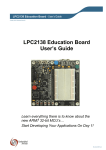
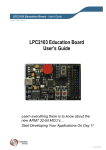
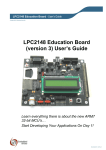
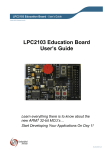
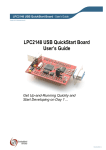
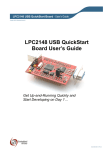
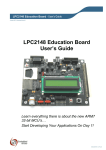
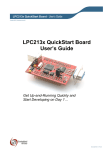
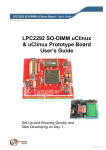
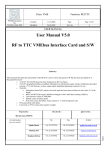
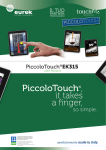
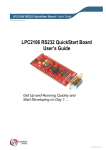
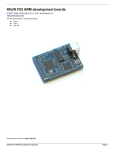
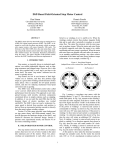
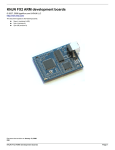
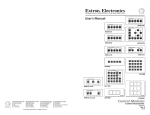

![ZXmore-V11-ConstructionKit [1144.78] KB](http://vs1.manualzilla.com/store/data/005859049_1-e30fafda14586d16f36a324828eeb8d9-150x150.png)
